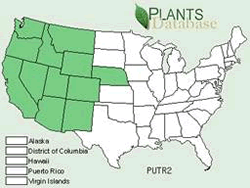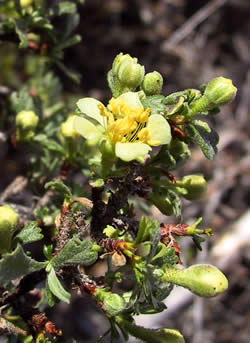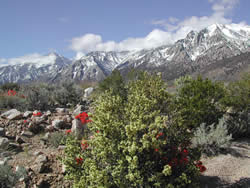Plant of the Week
 Range map of bitterbrush. States are colored green where the species may be found.
Range map of bitterbrush. States are colored green where the species may be found.
 Bitterbrush (Purshia tridentata). Photo by Steve Matson, courtesty CALPHOTOS.
Bitterbrush (Purshia tridentata). Photo by Steve Matson, courtesty CALPHOTOS.
 Bitterbrush (Purshia tridentata) habitat. Photo by Kathleen G. Nelson, Inyo Forest Botanist.
Bitterbrush (Purshia tridentata) habitat. Photo by Kathleen G. Nelson, Inyo Forest Botanist.
Bitterbrush (Purshia tridentata (Pursh) DC.)
By Forest Jay Gauna
Purshia tridentata is a plant of the Rosaceae, or rose family. Purshia refers to F.T. Pursh, a German-American botanist. Pursh originally described this plant, and Augustin de Candolle, who named the genus after him, later revised its taxonomy. Tridentata refers to the three "teeth" on the end of the leaf. The full common name is "antelope bitterbrush," signifying its known importance as a browse plant for wildlife.
Bitterbrush is well adapted to desert life: with water-loss resistant leaves and long taproots, a bitterbrush plant may be decades old. Some have been discovered to be well over a century old. The shrub shape may vary considerably, from a spreading prostrate form to nearly a tree. The thick leaves are small, typically less than an inch long, and green underneath, a hairy surface that gives the entire plant a dusty green appearance. Look for the three well-separated teeth on the end of the leaf. Be sure not to confuse this thick, green leaf with the thinner, greyer three-toothed leaf of sagebrush (Artemisia tridentata), which is a common associate. The small flowers have five yellowish petals. After looking at them for a while, they do begin to look distantly related to the wild rose.
Besides being an important plant for wildlife, bitterbrush is also used in rangeland restoration. It is a hardy plant of the wild landscapes of Nevada and the intermountain West, along with other common species such as rabbitbrush and sagebrush. Native Americans and Mexicans use it for medicinal purposes, and a purplish dye can be made from a part of the seed. The dry wood is used for firewood.

